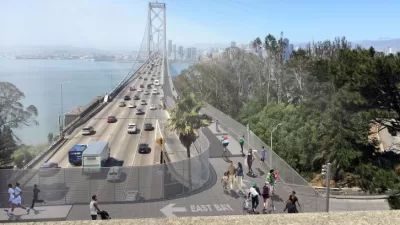One of the nation's busiest commute corridors will get a lot busier in coming decades with no large infrastructure investment in sight. SPUR has some ideas about how the East Bay to San Francisco corridor can be improved right now.
Dylan Pilaar, Erin McAuliff, and Ratna Amin report on the state, and possible future, of the Bay Area's highest-volume commute: the Bay crossing between San Francisco and the East Bay. Despite increased demand in recent years, no new transportation capacity has been added to the route since 1972. Meanwhile, transbay trips are expected to grow by 70 percent between 2015 and 2035.
"Consensus is brewing that a new transbay rail line is needed to solve the problem. A big-picture vision for a second transbay BART tube (which SPUR called for in a 2009 Report), has gained traction in recent months. A second transbay rail tube — be it for BART, standard rail like Caltrain or Amtrak, high-speed rail or a combination of the three — is essential to solving the Bay Area’s transit capacity crunch."
Such solutions, however, are likely to take decades to plan and deliver, and will not help relieve transportation crunches in the meantime. The article, written by the trio for SPUR on the Medium website, focuses on what can be done while the region works toward next big transportation investments. For a start:
"The new San Francisco Bay Area Core Capacity Transit Study, which kicks off this year, will identify short-, medium- and long-term improvements in the transbay travel corridor. The study — which involves the Metropolitan Transportation Commission, the San Francisco Municipal Transportation Agency, the San Francisco County Transportation Agency, BART, AC Transit, the Water Emergency Transportation Agency and Caltrain — will paint a clear picture of commuter travel patterns and determine how best to address the needs of Bay Area commuters."
SPUR also recommends additional measures while that study is underway, including maximizing capacity and efficiency on the BART system, adding bus lanes on the Bay Bridge and its highway approaches, deploying new demand pricing models to provide incentives for alternative modes, and several more recommendations.
FULL STORY: How Can We Move More People Between SF and the East Bay?

Planetizen Federal Action Tracker
A weekly monitor of how Trump’s orders and actions are impacting planners and planning in America.

Maui's Vacation Rental Debate Turns Ugly
Verbal attacks, misinformation campaigns and fistfights plague a high-stakes debate to convert thousands of vacation rentals into long-term housing.

Restaurant Patios Were a Pandemic Win — Why Were They so Hard to Keep?
Social distancing requirements and changes in travel patterns prompted cities to pilot new uses for street and sidewalk space. Then it got complicated.

In California Battle of Housing vs. Environment, Housing Just Won
A new state law significantly limits the power of CEQA, an environmental review law that served as a powerful tool for blocking new development.

Boulder Eliminates Parking Minimums Citywide
Officials estimate the cost of building a single underground parking space at up to $100,000.

Orange County, Florida Adopts Largest US “Sprawl Repair” Code
The ‘Orange Code’ seeks to rectify decades of sprawl-inducing, car-oriented development.
Urban Design for Planners 1: Software Tools
This six-course series explores essential urban design concepts using open source software and equips planners with the tools they need to participate fully in the urban design process.
Planning for Universal Design
Learn the tools for implementing Universal Design in planning regulations.
Heyer Gruel & Associates PA
JM Goldson LLC
Custer County Colorado
City of Camden Redevelopment Agency
City of Astoria
Transportation Research & Education Center (TREC) at Portland State University
Jefferson Parish Government
Camden Redevelopment Agency
City of Claremont





























